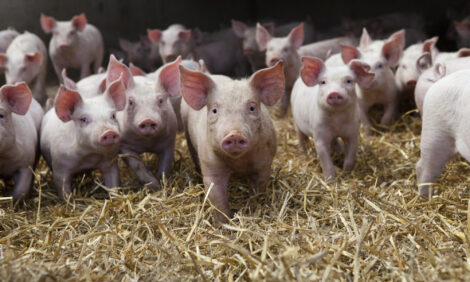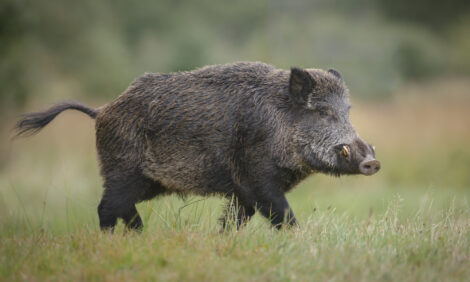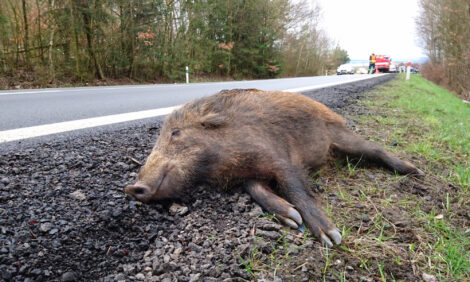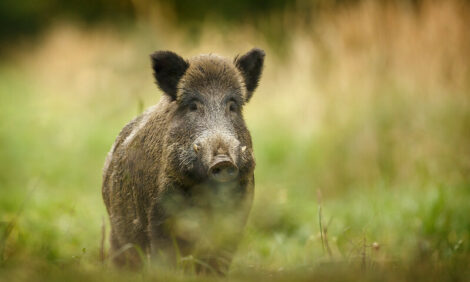



African swine fever in wild boar: surveillance & disease management
Early detection is fundamentally important for its controlEditor's note: the following is an excerpt from African swine fever in wild boar populations - ecology and biosecurity. It was created by the FAO, WOAH and European Commission. Additional content from the booklet will be shared as an article series.
Early detection
Early detection of ASF in wild boar populations is fundamentally important for its control. Prompt detection of the virus following its introduction in an ASF-free area increases the chances that its spread will be localized, negative economic consequences reduced and the situation possibly reversed back to normal. To build an early detection system that is sensitive enough to achieve these tasks, several epidemiological factors and limitations specific to this complex disease must be considered. These include the relationships between the host recovery rate and virus lethality, the ecology of wild boar, hunting limitations (as the means of accessing animals for testing) and available diagnostic techniques.
According to the definition of per capita rate (Anderson and May, 1991; Scott and Smith, 1994), the daily probability that an ASF-infected wild boar will die is 0.9/5 (90 percent probability the animal will die in five days), while a wild boar living in a hunting ground has a 40 percent chance of being hunted during the autumn-winter period (0.4/100 days). The per capita lethality rate of an infected animal is therefore 45 times higher than the per capita rate at which a wild boar is hunted, at 0.18day-1 (0.90/5) and 0.04day-1 (0.04/100), respectively. This indicates that the speed at which the virus kills infected wild boar is 45 times faster than the capacity of hunters to bag animals (0.18/0.004 hunting rate).
Due to this high lethality rate (i.e. the daily rate at which the genotype II ASFV kills infected animals), only passive surveillance offers the possibility of detecting it promptly, simply because the virus works faster than hunters (Figure 18). The early detection of the disease has a very strong impact on the effectiveness of the entire ASF crisis management system. Delays in discovering the virus prompt rapid and often poorly predictable increases in the infected area. The exponential spatial progression of the infected area means that the situation will be more difficult to manage (number of carcasses, tests for hunted animals), resulting in a greater likelihood of the virus escaping from the area. Without the effective early detection of the virus, any future efforts to eradicate the disease will be strongly compromised.
How can the efficiency of early detection be maximized?
Diseases are detected based on the simple relationship between detection efforts and the actual number of cases. As is the case with any activity, the amount of effort put into achieving a task greatly impacts its success. If no searches are being carried out for carcasses, it is likely that the pathogen will never be detected. The number of dead wild boar in the forest and the effort put into finding carcasses should be reasonably correlated and sustained both during peaceful periods and periods of escalation. In inaccessible forests, not a single dead wild boar will be reported even if the disease has killed hundreds of them.
In contrast, areas that are generally frequented by the general public, hunters and loggers, will likely have more prompt reports, which will help better reveal the scale of an unfolding epidemic. The mix of actions involved in the early detection of the virus therefore translates into what is known in epidemiological terms as the sensitivity of the system. A 100 percent sensitive early detection system should be able to detect the very first case of ASF in an area considered disease-free.
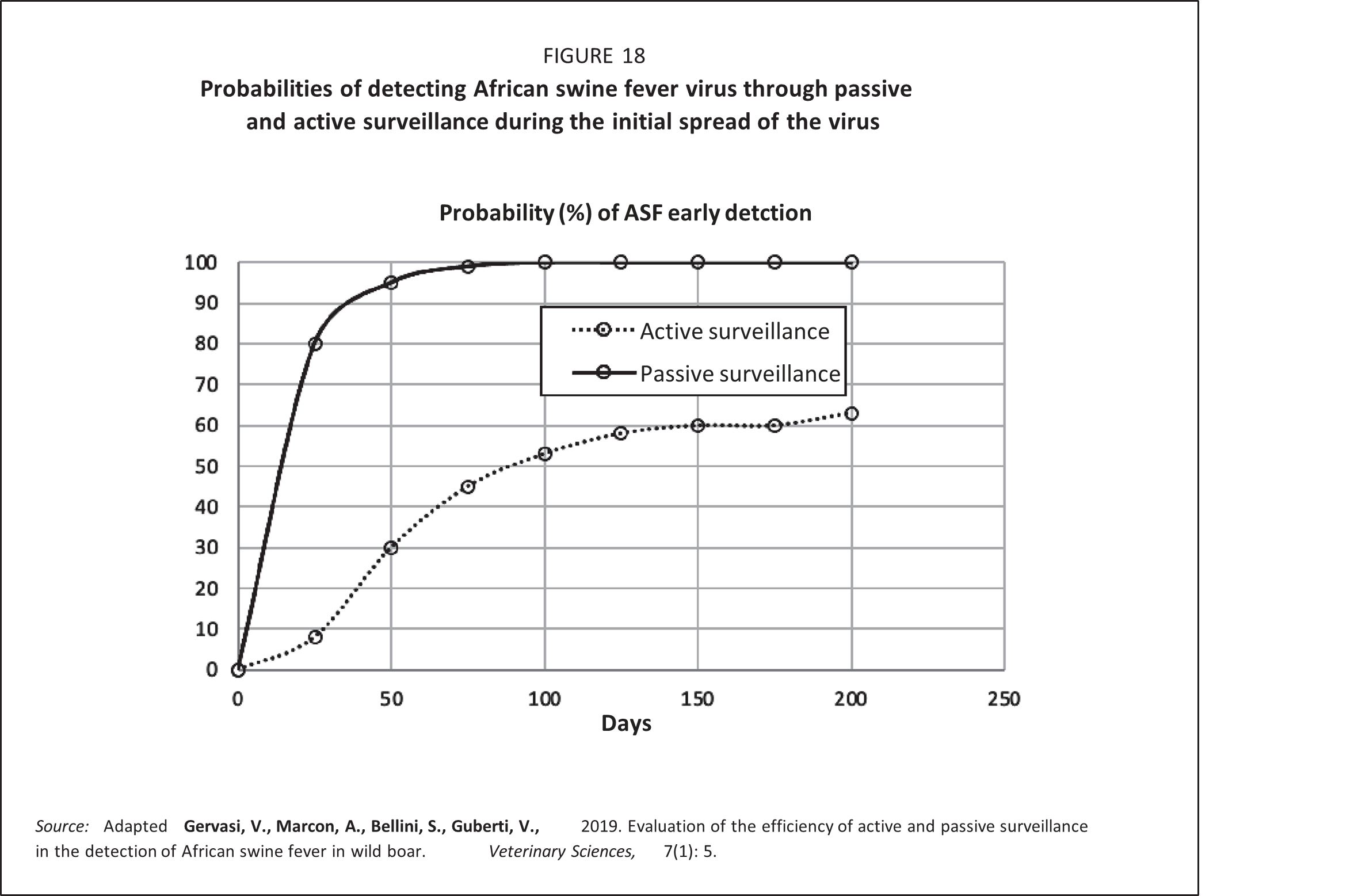
Provided that passive surveillance based on finding dead animals is the selected approach for the early detection of ASFV, its sensitivity can be evaluated in a very simple way by asking wildlife management authorities in the area how many dead wild boar they normally detect in the absence of ASF. The answers “never” or “none”, which are often provided as evidence of good management and health conditions of the population, indicate that there is a problem. As with any other species, wild boar have a certain level of natural mortality, with reports of “no dead animals” suggesting that the passive surveillance in place is not effective or sensitive enough to detect baseline mortality levels. The level of natural mortality among the species is not easy to determine and estimates differ across locations. However, in ASF-free areas across the European Union, passive surveillance should certainly detect at least some dead animals. A rough conservative proportion to consider is that the number of wild boar found dead for any reason approximates 1 percent of the current wild boar population estimate. The logic behind this is that the natural wild boar mortality is estimated at about 10 percent per year, with at least 10 percent of wild boar carcasses likely to be reported (and hopefully tested), which results in 1 percent overall wild boar population estimate at any given period.
If such a baseline level of passive surveillance is normally practised and sustained in areas unaffected by the disease, the task of early detection of the virus is more achievable, though could still be delayed due to several limitations as shown in Table 2.
Table 2 shows that it is almost impossible to have a 100 percent efficient early detection (e.g. to immediately detect the very first wild boar that died from ASF). The virus is more likely to be detected when the epidemic has already produced a number of carcasses, which were missed or not reported. However, the calculations show that the best early detection strategy is to look for carcasses rather than trying to bag and test animals. The two weakest steps in passive surveillance (discovering and reporting) can be improved through active, well-planned and organized carcass searches coordinated by competent authorities, which can also ensure that maximum sampling and testing rates are achieved. Enhancing carcass searches and reporting is not an easy task. The terrain and weather, availability of personnel, awareness of the local population and logistical issues (such as transportation) limit active carcass searches. In high-risk areas, awareness campaigns should address the importance of reporting any dead animals to the competent authorities. Financial incentives, the use of specially trained dogs, the application of drones and thermal imaging and any other methods that increase the chances of discovering and testing carcasses with ASF improve the sensitivity of passive surveillance.
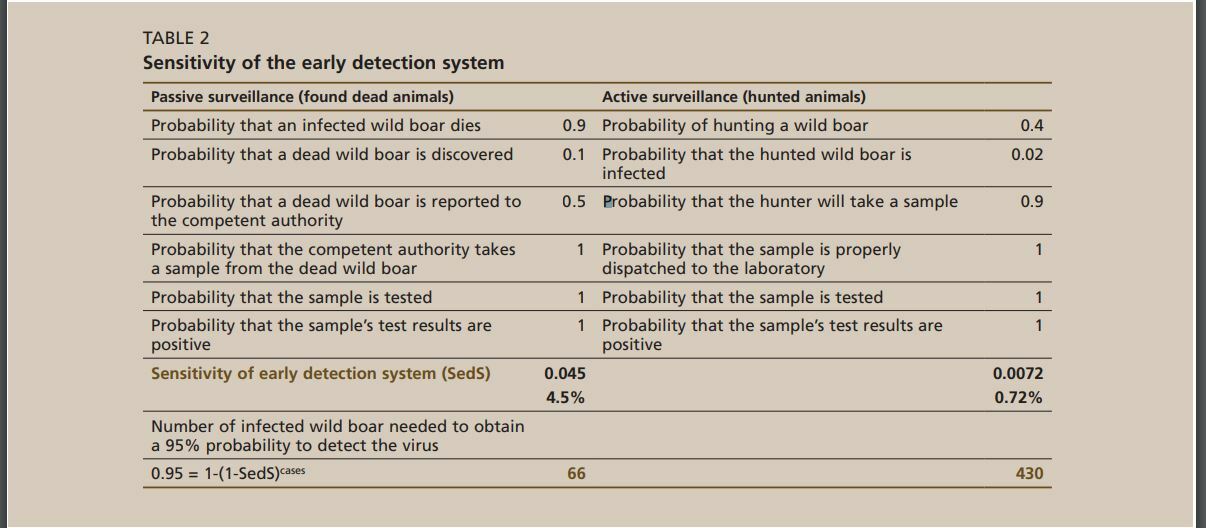
How many wild boar are already dead?
Since the sensitivity of the early detection system based on carcass detection is imperfect, it is likely that the first infected wild boar (considered an “index case”) is just one individual among others that did not survive the infection. For this reason, efforts should be made to promptly investigate the possibility of a much wider spatial distribution of the virus and to establish the size of the virus circulation area. The basic reproduction rate of ASF in wild boar during an active epidemic is currently estimated at two. This means that during the initial epidemic phase, any infected wild boar will on average infect two other wild boar. Since ASF has a serial interval of approximately seven days (incubation plus sickness), the number of dead wild boar likely to be found (i.e. expected to have died) will be twice the number of carcasses found the previous week. Targeting the search of carcasses in an area and defining realistic tasks will motivate the involved personnel and enable more robust epidemiological data to be obtained that will inform further interventions.
Planning a carcass search: area and personnel
Active searching for carcasses is a very time-consuming but critically important activity to reveal the situation so that appropriate decisions can be made to help stop the spread of the virus. There are no strict rules on where to look for carcasses to increase detection rates. Sick wild boar tend to prefer colder, moist forest habitats, possibly owing to their high fever (Morelle et al., 2019). Infected carcasses are more likely to be found in young broad-lived forests or in meadows with significant vegetation (Cukor et al., 2020b). Since wild boar apparently do not come in contact with infected carcasses before 12–15 days post-mortem (Probst et al., 2017; Cukor et al., 2020a), carcasses should ideally be removed every two weeks. However, it is not always possible to implement this “golden rule” standard, especially when human resources are limited. In a best case scenario, a group of five people can actively search an area of 1–1.5 km2 per day, making the standard increasingly difficult to carry out when the infected area is already quite large. For relatively small infected areas, and when the disease is still in an invasion or early epidemic phase, the standard is more realistic to use. When there are not enough people to carry out a thorough search, forest habitats can be quickly scanned, even if accuracy and coverage need to be sacrificed. Observations show that more than 80 percent of wild boar die in forests, suggesting that sick animals perceive this habitat as a safer and more comfortable environment (Cukor et al., 2020b). Farmers, fishers and the general public tend to frequent less-forested areas, where they are more likely to come across carcasses incidentally, a fact that also requires consideration. The use of new search techniques (e.g. drones, dogs) can be a helpful addition to the strategy, but the role of people should not be replaced by their means. It is important to involve professionals (e.g. forestry corp, professional hunters and gamekeepers, rangers of protected areas) to avoid placing too much of a demand on excessive effort from amateur hunters.
Virus prevalence estimates
The prevalence of ASFV in wild boar can only be estimated by testing samples obtained during hunting activities carried out as part of active surveillance during the endemic phase. In such epidemiological settings a proper sampling intensity can be ensured that will achieve a desired level of confidence, though it must be highlighted that hunting always provides opportunistic samples. For low wild boar densities, and when prevalence declines below a threshold value (about 1 percent), prevalence estimates progressively lose their precision until they reach a point at which the virus can no longer be detected. Positive results instead come from serological tests, suggesting a detectable “accumulation” of disease survivors in the population, which is an aftermath of the epidemic phase that further develops into an endemic equilibrium.
When prevalence drops below 1 percent and the population density of wild boar is very low (around 0.1–0.3 wild boar per km2), the usual sampling rates obtained through recreational hunting (about 40 percent of the post-reproductive wild boar population) cannot ensure sufficient statistical power to detect the virus. During this phase, active virological surveillance through hunting could provide the false impression that the disease has vanished spontaneously. However, evidence obtained in such epidemiological settings cannot prove there is no ASF, which should be demonstrated through a special strategy for the situation.
Regaining an African swine fever-free status
By now only two affected countries (Belgium and Czechia) could regain an ASF-free status after months of extensive efforts. According to WOAH regulations, this status can be self-declared after one year of monitoring that proves an absence of the virus. Such monitoring requires a specific surveillance plan that can demonstrate a defined level of confidence that the virus has disappeared from the population and can no longer be detected. As previously mentioned, at the end of the epidemic phase, the epidemiological situation often becomes difficult: the virus may still be present, but for statistical reasons, may not be proved by virological surveillance. A decline in seropositive animals may be reported, again invoking the false impression of an improving situation.
As the number of reported dead animals decreases due to declining wild boar density (both as a result of ASFV-induced mortality and population control measures), the epidemiological situation evolves into an endemic phase. This phase is characterized by an extremely low prevalence of the virus among the population, with rare sporadic detections and intervals in detection that are sometimes several months (up to 2–3 years according to Lange, Reichold and Thulke, 2021).
When the wild boar population is naturally restored in this epidemiological scenario, ASF will re-emerge in the area and numbers of dead and virus-positive animals will again reach the detection threshold. To declare a country ASF-free, the EFSA (2021) suggested the use of an ASF exit strategy that ensures a high level of confidence, while reducing the time needed to carry out the procedure. The strategy involves two different but interconnected periods. The fist is known as the “screening phase”, which involves usual (standard) active surveillance (sampling and testing of all hunted animals) combined with opportunistic passive surveillance (i.e. incidental detection in the absence of active carcass searches). The second phase is known as the “confirmation phase”, which exclusively involves enhanced passive surveillance, the duration of which is inversely correlated to the length of time of the screening phase.
The number of carcasses to be detected during the confirmation phase is determined according to the estimated size of the infected wild boar population. It should be noted that at the end of the endemic phase, the population density of wild boar is always low, as is the number of wild boar carcasses expected to be detected (at least two per 1 000 km2).
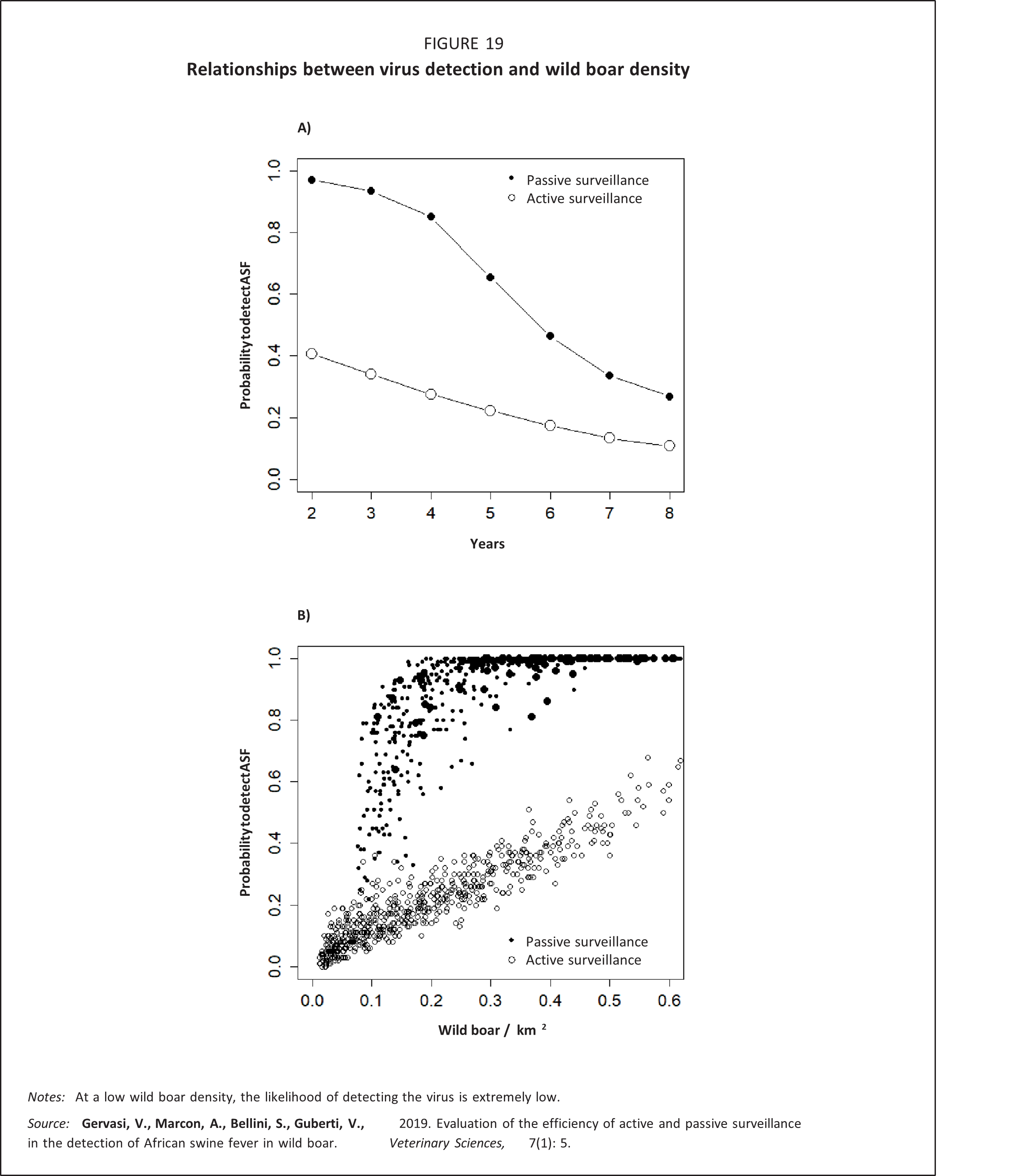
Provided that the country passed the defined period of the confirmatory phase without the detection of virus-positive animals or carcasses, the country (or an area of a country) can claim an ASF-free status with a desired level of confidence.
Guberti, V., Khomenko, S., Masiulis, M. & Kerba S. 2022. Chapter 4. African swine fever in wild boar – Ecology and biosecurity. Second edition. FAO Animal Production and Health Manual No. 28. Rome, FAO, World Organisation for Animal Health and European Commission. https://doi.org/10.4060/cc0785







